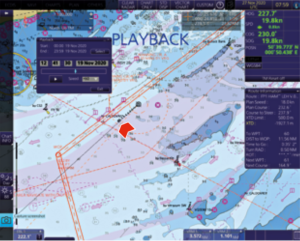The Charity
Aviation
Maritime
Colregs Rule 10 Incident

Initial Report
Outline:
A report highlighting a close quarters situation between a commercial fishing vessel and a container ship.
What the reporter told us:
A fishing vessel was engaged in fishing within the central separation zone of a major TSS following a basic loop pattern of courses, northwards on 330° then turning to port to follow the reciprocal heading (150°) to the south between the NE and SW traffic separation lanes at 3.3kts. A large container vessel was proceeding at 20kts in the SW lane, holding close to the southern edge of the lane.
On nearing the northern limit of the separation zone, the fishing vessel commenced her planned turn to port to reverse her course. At this time, the container vessel altered course to port leaving the SW lane and entering the separation zone. As the fishing vessel continued her turn to port passing through heading 170° the skipper found himself on the stbd bow of the container vessel and needed to make an emergency manoeuvre to stbd to avoid a close quarters situation or possible collision.
Further dialogue:
CHIRP discussed the report with both the reporter (fishing vessel’s fleet manager) and skipper to clarify some details and timing of the incident and garner any additional information. The fishing vessel was less than 12 months old and was fully equipped with a range of the latest navigation and fish finding equipment including ENC’s. Furthermore, the skipper’s emergency manoeuvre to starboard had taken the boat over a shallower patch which fouled the fishing gear, this was later cleared without damage or loss.
CHIRP also contacted the ISM managers for the container vessel, and details of the reported incident were passed to the DPA. Subsequently, after contacting the captain of their vessel, the DPA reverted to CHIRP with a response including a series of screen shots from the bridge of the container ship and a commentary from the captain with regards to the incident. The screen shots show that the container vessel was south of the planned route and outside the charted safety corridor in a position close to the boundary between the SW lane and the central separation zone.

Screen shot from the container vessel.
Both the reporter and the captain of the container ship quoted rule 10 of the Collision Regulations to support their position that the other party was at fault.
Rule 10 (e) (ii) allows vessels to engage in fishing within a separation zone.
and additionally
Rule 10 (b) (ii) states: a vessel using a traffic separation scheme shall: so far as practicable keep clear of a traffic separation line or separation zone.
However
Rule 10 (i) states: A vessel engaged in fishing shall not impede the passage of any vessel following a traffic lane.
CHIRP comment:
There are some discrepancies between the two accounts of the same event, however it is not CHIRP’s function to carry out a forensic analysis of an incident but rather to highlight the situation that developed and to promote good practice in navigation and seamanship.
There are two sides to every story and those sides are normally dictated by the individual’s perception of events. Different vessels have different handling characteristics, a 340m container vessel is much less manoeuvrable than a 34m fishing vessel and as such must plan and execute collision avoidance manoeuvres much earlier. For that reason it would be prudent not to follow a track unnecessarily close to a separation zone where fishing vessels may well be legitimately engaged in fishing and can change course erratically. However, vessels engaged in fishing and other small craft should bear in mind that the bridge team on large vessels are very uncomfortable with smaller vessels operating in close proximity to them, inside the reaction radius of the larger vessel, thereby taking any form of control away from the larger vessel. It will serve all seafarers well to consider any developing situation from the other vessel’s point of view, and to follow the normal precautions required by the ordinary practice of seamen.
The Collision Regulations have the answer to any situation from initial detection to finally passing clear, but there is always the matter of perception regarding the situation, which may vary with your height of eye.
Report Ends……………………..







